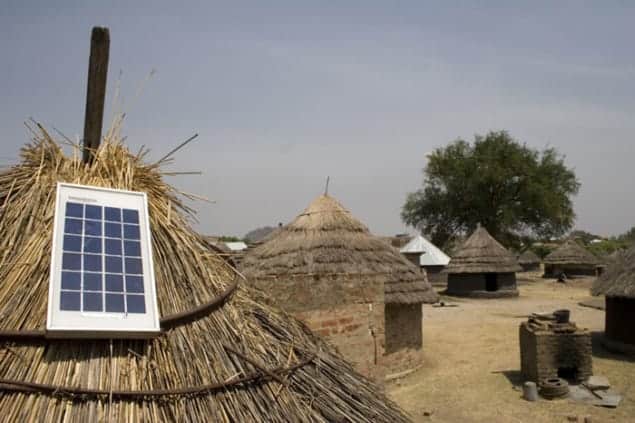
A UK-based start-up is developing printable, thin-film plastic solar cells aimed at providing affordable electricity to individual dwellings that have no grid connection, such as those in rural Africa. The flexible device’s photoactive layer will be a blend of two organic semiconductor materials positioned between metallic electrodes, all sandwiched by plastic substrates.
Slashing costs
Eight19, a Cambridge University spin-off firm, is named after the eight min, 19 s it takes sunlight to reach the Earth. The company believes that sheets of the lightweight plastic thin film will slash the cost of transporting and installing solar panels compared with conventional silicon-based solar panels or glass-based thin-film solar cells. This should make it more affordable for farmers and villagers in remote areas, who can fix the sheets to their roofs to power homes that do not have electricity.
“Today, 50% of the cost of solar power is the installation, and that’s going up as solar costs come down,” says Simon Bransfield-Garth, CEO of Eight19. Eight19 plans to start manufacturing the sheets by 2013, using reel-to-reel printing techniques.
Interactive boundaries
The design involves creating an inner photoactive layer using two organic semiconductor materials: a polymer for the “donor” portion and, most likely, a fullerene for the “acceptor”. Sunlight creates excitons – bound pairs of electrons and holes in the semiconductors. These diffuse into an interface formed where the polymer and fullerene meet – an artificial “heterojunction” – and an energy offset splits the pairs apart. The electrons move to the film’s metallic cathode layer and the holes to the anode.
Eight19 plans to use a transparent metal for the anode, so that sunlight is not prevented from hitting the photoactive layer. It has ruled out one logical choice – indium tin oxide (ITO), which is typically used in LCD displays – as being too expensive. “We’re working on ITO-free transparent conductors,” says Kieran Reynolds, Eight19’s chief operating officer. “And we’re making good progress.” The cathode could be an opaque metal, such as silver, aluminium or copper, that would cause the light to bounce back onto the photoactive layer or, in some applications, a semitransparent conductor.
Sheets and layers
The outer protective layers will be formed with polyethylene terephthalate (PET) – the material used to make plastic bottles – so that the films remain lightweight and flexible. The company will deposit the electrode and photo layers onto a PET substrate using reel-to-reel printing. Although PET will not last as long as glass – an Eight19 solar module will last about five years compared with 25 years for conventional panels – Eight19 can make tougher versions by adding extra PET layers.
The company claims that a small, 2.5 W sheet should provide enough electricity for rudimentary LED lighting and mobile-phone charging. Larger sheets could power media devices and appliances.
As Eight19 gears up, it is seeding the market in Kenya, South Sudan, Malawi and Zambia using conventional solar panels and an innovative service model. The company sells $10 kits comprising small, 2.5 W panels, two LED lamps and a rechargeable lithium-ion battery. For $1 a week, kit owners buy a scratch card from a merchant, text the card’s number and then receive a code they enter into a digital keypad on the battery pack to allows unlimited use of the panel. The system, which Eight19 says can provide rudimentary lighting, is aimed at replacing costly and environmentally hazardous kerosene or diesel generators in off-grid rural areas.



